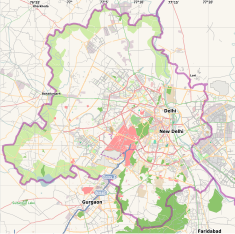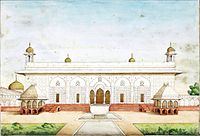|
Red Fort
The Red Fort, also known as Lal Qila (Hindustani: [laːl qiːlaː]) is a historic Mughal fort in Delhi, India, that served as the primary residence of the Mughal emperors. Emperor Shah Jahan commissioned the construction of the Red Fort on 12 May 1639, following his decision to relocate the Mughal capital from Agra to Delhi. Originally adorned in red and white, the fort's design is attributed to Ustad Ahmad Lahori, the architect behind the Taj Mahal. The Red Fort represents the pinnacle of Mughal architecture during Shah Jahan's reign, blending Persian palace influences with indigenous Indian architectural traditions. The fort was plundered and stripped of its artwork and jewels during Nadir Shah's invasion of the Mughal Empire in 1739. Most of the fort's marble structures were subsequently demolished by the British following the Indian Rebellion of 1857. The fort's defensive walls were largely undamaged, and the fortress was subsequently used as a garrison. On 15 August 1947, the first Prime Minister of India, Jawaharlal Nehru, raised the Indian flag above the Lahori Gate. On India's Independence Day, observed annually on 15 August, the Prime Minister ceremonially raises the Indian tricolour flag at the main gate of the historic fort and delivers a nationally broadcast address from its ramparts. The Red Fort, as part of the Red Fort Complex, was recognized as a UNESCO World Heritage Site in 2007.[1][2] EtymologyThe name Red Fort is a translation of the Hindustani Lāl Qila (Hindi: लाल क़िला, Urdu: لال قلعہ),[3][4] deriving from its red sandstone walls. The term Lal is derived from Hindi, meaning "red," while Qila originates from Arabic, signifying "fortress". Originally referred to as the "Blessed Fort" (Qila-i-Mubārak), the Red Fort served as the residence of the imperial family.[5][6] Agra Fort is also known as Lāl Qila. History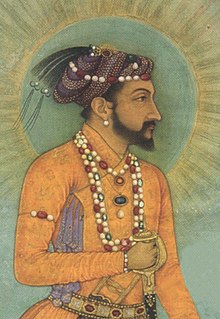 Emperor Shah Jahan commissioned construction of the Red Fort on 12 May 1638, following his decision to shift his capital from Agra to Delhi. Originally adorned in red and white, the favorite colors of Emperor Shah Jahan,[7] the design of the Red Fort is attributed to the architect Ustad Ahmad Lahori, renowned for his work on the Taj Mahal.[8][9] The fort straddles the Yamuna River, which fed the moats surrounding most of the walls.[10] Construction began in the sacred Islamic month of Muharram, on 13 May 1638.[11]: 01 Supervised by Shah Jahan, it was completed on 6 April 1648.[12][13][14] Unlike other Mughal forts, the Red Fort's boundary walls are asymmetrical to contain and subsume the older Salimgarh Fort.[11] The fortress-palace served as the centerpiece of Shahjahanabad, the city now known as Old Delhi. Shah Jahan's successor, Emperor Aurangzeb, enhanced the Red Fort by adding the Moti Masjid (Pearl Mosque) to the emperor's private quarters. He also constructed barbicans in front of the two main gates to create a more circuitous approach to the palace.[11]  Following the death of Emperor Aurangzeb, the administrative and fiscal structure of the Mughal dynasty experienced a decline, leading to the degeneration of the palace during the 18th century. In 1712, Jahandar Shah was crowned the Mughal Emperor. Within a year of commencing his rule, Shah was murdered and replaced by Farrukhsiyar. In 1739, the Persian emperor Nadir Shah decisively defeated the Mughal army, despite its considerable strength of approximately 200,000 soldiers.[15] Following his victory, he plundered the Red Fort, seizing its treasures, including the legendary Peacock Throne. After three months, Nadir Shah returned to Persia, leaving the city a shadow of its former self and the Mughal Empire severely weakened under Muhammad Shah's reign.[11] The internal weaknesses of the Mughal Empire reduced the Mughals to titular rulers of Delhi. A treaty signed in 1752 established the Marathas as the protectors of the throne in Delhi.[16][17] The 1758 Maratha victory over the Afghans at Sirhind, and followed by their defeat at Panipat[18] catapulted them into further conflict with Ahmad Shah Durrani.[19][20] In 1760, the Marathas stripped and melted the silver ceiling of the Diwan-i-Khas to raise funds for the defence of Delhi from the armies of Ahmed Shah Durrani.[21][22] In 1761, after the Marathas lost the third battle of Panipat, Delhi was raided by Ahmed Shah Durrani. Ten years later, the Marathas, acting at the behest of the exiled Emperor Shah Alam II, recaptured Delhi from the Rohilla Afghans. Mahadaji Shinde, the commander of the Maratha Army, restored Shah Alam II to the throne.[23] In 1764, the Jat ruler of Bharatpur, Maharaja Jawahar Singh, attacked Delhi and eventually captured the Red Fort of Delhi on 5 February 1765.[24] Two days later, after exacting tribute from the Mughals, the Jats withdrew their forces from the Red Fort, seizing the Mughal throne—often regarded as the pride of the dynasty—and the fort's doors as trophies. The throne now adorns the palace at Deeg, serving as a historical centerpiece. The doors are located in the Lohagarh Fort of Bharatpur.[25] In 1783, Sikh Misls led by Jassa Singh Ahluwalia, Jassa Singh Ramgarhia, and Baghel Singh Dhaliwal conquered Delhi and the Red Fort. With a consolidate force consisting of 40,000 troops, they looted the area spanning from Awadh to Jodhpur. After negotiations, the Sikhs forces agreed to withdraw Delhi and reinstate the Mughal emperor Shah Alam II. As a condition of their retreat, the Jats stipulated the construction of seven Sikh gurdwaras in Delhi, including the Gurudwara Sis Ganj Sahib in Chandni Chowk.[26] In 1788, a Maratha garrison occupied the Red Fort and Delhi, offering protection to the Mughal Emperor. Mahadaji Shinde negotiated a treaty with the Sikhs, cautioning them against entering Delhi or levying the Rakhi tribute. Control of the fort subsequently passed to the East India Company after the Second Anglo-Maratha War in 1803.[27] During the Second Anglo-Maratha War, the forces of the East India Company defeated the Maratha troops led by Daulat Rao Scindia in the Battle of Delhi; This event marked the end of Maratha control over Delhi and their authority over the Red Fort.[28] After the battle, the British East India Company took over the administration of Mughal territories and installed a Resident at the Red Fort. The last Mughal emperor to occupy the fort, Bahadur Shah II, became a symbol of the 1857 rebellion against the British East India Company in which the residents of Shahjahanabad participated. Despite its position as the seat of Mughal power and its defensive capabilities, the Red Fort was not a site of any engagements during the 1857 uprising against the British. After the rebellion was subdued, Bahadur Shah II left the fort on 17 September and was subsequently apprehended by British forces. Bahadur Shah Zafar II returned to Red Fort as a British prisoner, was tried in 1858, and exiled to Rangoon on 7 October that year.[29] After the conclusion of the rebellion, the British sacked the Red Fort before ordering its systemic demolition. As a result of this widespread destruction, 80% of the fort's structures were demolished, including the stone screen that once connected the pavilions along the river-facing façade of the fort.[30] All furniture was either removed or destroyed; the harem apartments, servants' quarters, and gardens were demolished, and a line of stone barracks erected atop them.[31] Only the marble buildings on the east side at the imperial enclosure escaped complete destruction, although they were damaged while demolition was underway. While the defensive walls and towers were relatively unscathed, over two-thirds of the inner structures were demolished.[32][33] Lord Curzon, who served as the Viceroy of India from 1899 to 1905, initiated restoration efforts for the Red Fort. These included the reconstruction of its walls and the revival of its gardens, complete with an updated watering system.[34]  The majority of the jewels and artwork housed in the Red Fort were looted during Nadir Shah's invasion in 1747, and yet again in the aftermath of the Indian Rebellion of 1857. They were eventually sold to private collectors or the British Museum, the British Library, and the Victoria and Albert Museum. For instance, Shah Jahan's jade wine cup and Bahadur Shah II's crown, both looted, are currently held in London. Various requests for restitution have so far been rejected by the British Government.[35]  1911 witnessed the visit of King George V and Queen Mary for the Delhi Durbar. In anticipation of their visit, some buildings were restored. The Red Fort Archaeological Museum was moved from the drum house to the Mumtaz Mahal. The INA trials, also known as the Red Fort Trials, refer to the courts-martial of a number of officers of the Indian National Army. The first trial was conducted at the Red Fort between November and December 1945. On 15 August 1947, the first prime minister of India, Jawaharlal Nehru, raised the Indian national flag above the Lahore Gate.[36] After Indian independence, the site experienced few changes, and the Red Fort continued to be used as a military cantonment. A significant portion of the Red Fort remained under the control of the Indian Army until 22 December 2003, when it was transferred to the Archaeological Survey of India for restoration and conservation.[37][38] In 2009, the Comprehensive Conservation and Management Plan (CCMP), prepared by the Archaeological Survey of India under the auspices of a Supreme Court direction to revitalise the fort, was announced.[39][40][41] In recent years, several new museums and galleries have been added to the Red Fort complex. Four of these museums, inaugurated in 2019, are housed in the colonial-era barracks within the complex. Barrack B1 is dedicated to the 1857 War of Independence, Barrack B2 commemorates the Jallianwala Bagh massacre, and Barrack B3 focuses on Subhas Chandra Bose and the Indian National Army movement. Barrack B4, known as Drishyakala, is a collaboration between the Archaeological Survey of India and the Delhi Art Gallery, showcasing Indian art. The earlier museums, including the Indian Freedom Fighters' Museum, the Mumtaz Mahal Museum, and the Naubat Khana Museum, have been closed, with their exhibits relocated to these newly-established museums.[42] Archaeological findsArchaeological excavations at the Red Fort have unearthed several Ochre Coloured Pottery culture artefacts dating from 2600 BCE to 1200 BCE.[43] Modern era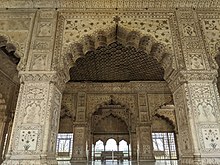  The Red Fort, the largest monument in Delhi,[44] is one of its most popular tourist destinations[45] and attracts thousands of visitors every year.[46] It is a monument of national significance; each year on India's independence day, observed on August 15, the Prime Minister hoists the national flag at the Red Fort and delivers a speech from its ramparts, which is broadcast nationwide.[47] The fort also appears on the back of the ₹500 note of the Mahatma Gandhi New Series of the Indian rupee.[48] The Red Fort's architectural features are in varying states of preservation. While some structures remain relatively intact, retaining their original decorative elements, others have suffered significant damage, with inlaid marble floral designs removed by looters. The water features, once extensive, are now dry. The tea house, though not preserved in its historical form, functions as a working restaurant. The mosque and the hammam (public baths) are closed to visitors, who can only view them through glass windows or marble latticework. Walkways within the complex are deteriorating, and public toilets are available both at the entrance and inside the premises. The Lahori Gate serves as the main entrance, leading to a shopping area with jewelry and craft stores. The complex also houses a museum of "blood paintings," which narrate the stories of 20th-century Indian martyrs, alongside an archaeological museum and an Indian war-memorial museum.[citation needed] 2000 terrorist attackThe Red Fort was the site of a terrorist attack on 22 December 2000, carried out by six Lashkar-e-Taiba operatives. Two soldiers and a civilian were killed in what the news media described as an attempt to derail the then-ongoing India-Pakistan peace talks.[49][50] SecurityTo ensure security and prevent terrorist attacks, stringent measures are implemented around the Red Fort on the eve of the Indian Independence Day. Delhi Police and paramilitary forces maintain a vigilant presence in the neighborhoods surrounding the fort, while National Security Guard sharpshooters are strategically stationed on high-rises near the site.[51][52] The airspace around the fort is a designated no-fly zone during the celebration,[53] and safe houses exist in the vicinity to which the prime minister and other dignitaries can be whisked off to in the event of an attack.[51] Adoption controversyIn April 2018, the Dalmia Bharat Group adopted the Red Fort for maintenance, development, and operations under the government's "Adopt A Heritage" scheme, through a contract worth ₹25 crores for a period of five years.[54] A memorandum of understanding was signed with the ministries of Tourism and Culture, and the Archaeological Survey of India.[55] The adoption of the Red Fort by a private entity sparked outcry and widespread debate, drawing criticism from the public, historians, and political parties. The move also led to the trending of the hashtag #IndiaOnSale on Twitter.[56] In May 2018, the Indian National Congress demanded the suspension of the agreement until an "impartial review" could be conducted by the Central Advisory Board of Archaeology or another recognized body of experts.[57] 2021 Indian farmers' Republic Day protestOn 26 January 2021, during the 2021 Indian farmers' Republic Day protest, a coterie of protesting farmers breached the fort, hoisted religious flags from its ramparts, and scaled the domes of the fort.[58] One of the farmers was witnessed climbing a flagpole in front of the fort and hoisting the Nishan Sahib pennant on the flagpole.[59] Provisions with the fort sustained damage owing to clashes between the protestors and the police.[60] The fort was vacated following police announcements. Architecture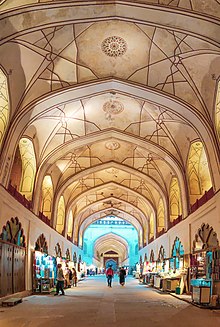 The World Heritage Convention characterises the Red Fort as embodying "the zenith of Mughal creativity". The fort synthesises Islamic palace structure with local traditions, resulting in a confluence of "Persian, Timurid, and Hindu architecture". The fort served as an inspiration for later buildings and gardens across the Indian subcontinent.[1] The Red Fort spans an area of 254.67 acres (103.06 hectares) and is enclosed by 2.41 kilometers (1.50 miles) of defensive walls.[61] These walls, reinforced with turrets and bastions, vary in height from 18 meters (59 feet) on the river-facing side to 33 meters (108 feet) on the city-facing side. The fort is octagonal, with the north–south axis longer than the east–west axis. The marble, floral decorations and the fort's double domes exemplify later Mughal architecture.[62] It showcases a high level of ornamentation, and the Kohinoor diamond was reportedly part of the furnishings. The artwork of the Red Fort integrates Persian, European, and Indian artistic traditions, culminating in a distinctive Shahjahani style characterized by its richness in form, expression, and color. The Red Fort is one of India's most significant architectural complexes, encapsulating a rich history and diverse artistic traditions. Even prior to its designation as a monument of national importance in 1913, efforts were undertaken to ensure its preservation for posterity. The Lahori and Delhi Gates were used by the public, whereas the Khizrabad Gate was reserved for the emperor.[11] The Lahori Gate serves as the main entrance to the Red Fort, leading to the Chhatta Chowk, a domed shopping area often referred to as the covered bazaar. Major structuresThe most significant surviving structures of the Red Fort include its walls and ramparts, the main gates, the audience halls, and the imperial apartments located along the eastern riverbank.[63] 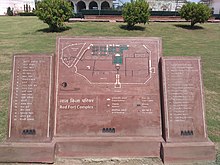 Lahori Gate The Lahori Gate, the primary entrance to the Red Fort, derives its name from its orientation towards the city of Lahore, which was once part of the Mughal Empire. During Aurangzeb's reign, the aesthetic appeal of the Lahori Gate was modified by the construction of a barbican, which Shah Jahan poetically described as "a veil drawn across the face of a beautiful woman."[64][65][66] Since 1947, on every Indian Independence Day, the national flag is ceremonially unfurled, and the Prime Minister delivers a speech from the ramparts of the Red Fort. Delhi GateThe Delhi Gate serves as the southern public entrance to the Red Fort and shares a similar layout and appearance with the Lahori Gate. Flanking the gate are two life-sized stone elephants positioned to face each other.[67] Chhatta ChowkAdjacent to the Lahori Gate is the Chhatta Chowk (or Meena Bazaar), where silk, jewellery and other items for the imperial household were sold during the Mughal period. This market was earlier known as Bazaar-i-Musaqqaf or Chatta-bazaar (both meaning "roofed market"). The Lahori Gate, the main entrance to the Red Fort, opens into an outer court that intersects with a large north–south street. This street originally separated the fort's military functions, located to the west, from the palaces situated to the east. At its southern end lies the Delhi Gate.[68] Naubat Khana 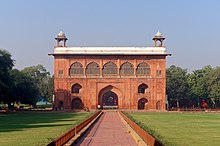 In the east wall of the court stands the now-isolated Naubat Khana (Persian: "Waiting Hall"), also known as Nakkar Khana (drum house). Music was performed daily at scheduled times within the Red Fort, and it was required of everyone, except members of the royalty, to dismount during these performances. Later Mughal emperors Jahandar Shah (1712–1713) and Farrukhsiyar (1713–1719) are believed to have been murdered here. The Indian War Memorial Museum is located on the second floor.[69] The vaulted arcade of the Chhatta Chowk ends in the centre of the outer court, which measured 540 by 360 feet (160 m × 110 m).[70] The side arcades and the central tank of the Red Fort were demolished following the 1857 rebellion. Diwan-i-Aam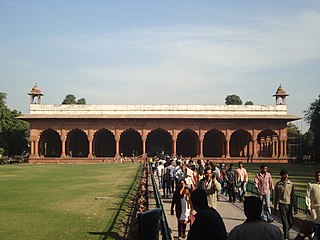 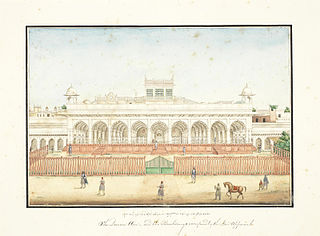 The inner main court to which the Nakkar Khana led was 540 feet (160 m) wide and 420 feet (130 m) deep, surrounded by guarded galleries.[70] On the far side is the Diwan-i-Aam, the Public Audience Hall. This venue was used to oversee official matters brought forth by commoners, including legal issues such as taxation, inheritance disputes, and matters related to awqaf (endowments). The hall's columns and engrailed arches exhibit fine craftsmanship, and the hall was originally decorated with white chunam stucco.[70] At the rear of the venue, in a raised recess, the emperor would grant audiences from the marble balcony (jharokha). The Diwan-i-Aam was also used for state functions.[62] The courtyard (mardana) behind it leads to the imperial apartments. Mumtaz Mahal The two southernmost pavilions of the palace are zenanas (women's quarters), consisting of the Mumtaz Mahal, built for Arjumand Banu Begum (Mumtaz Mahal), who was wife of the Mughal emperor Shah Jahan,[71] and the larger Rang Mahal was designated a resort for royal women.[72] The Mumtaz Mahal houses the Red Fort Archaeological Museum. Rang MahalThe Rang Mahal, meaning "Palace of Colours," served as the residence for the emperor's wives and mistresses. It derived its name from its vibrant paintings and intricate decorations, including a mosaic of mirrors. At its center lies a marble pool, which is fed by the Nahr-i-Bihisht ("River of Paradise").[73][72] Khas MahalThe Khas Mahal was the emperor's apartment. It was cooled by the Nahr-i-Bihisht.[73] Connected to it is the Muthamman Burj, an octagonal tower where the emperor appeared before the audience awaiting his presence at the riverbank. Such practices were common among most kings of the time, reflecting the prevailing norms and traditions of royal courts.[74] Diwan-i-Khas The Diwan-i-Khas, or Hall of Private Audience, was a space dedicated to addressing the official matters and requests of the nobility and members of the royal family. A gate located on the north side of the Diwan-i-Aam provided access to the innermost court of the palace, known as the Jalau Khana, as well as to the Diwan-i-Khas.[75] It is constructed of white marble and inlaid with precious stones. The once-silver ceiling has been restored in wood. François Bernier described witnessing the jewelled Peacock Throne here in the 17th century. At either ends of the hall, over the two outer arches, is an inscription by Persian poet Amir Khusrow:
Hammam The hammam (Arabic: حمّام) were the imperial baths, consisting of three domed rooms with white marble patterned floors.[76] It consists of three apartments separated by corridors and crowned with domes. The apartments are illuminated by a coloured glass skylight. The two rooms flanking the current entrance are believed to have served as bathing spaces for the royal children. The eastern apartment, featuring three fountain basins, was primarily used as a dressing room. Each room had a central fountain, and one included a marble reservoir embedded in the wall. According to legend, perfumed rose-water once flowed from the taps. The western apartment was designated for hot or vapour baths, with heating arrangements installed in its western wall.[77] Baoli The baoli (step-well) at the Red Fort, Delhi The baoli (step-well) is one of the few structures within the Red Fort that survived the widespread demolitions carried out by the British after the Indian Rebellion of 1857. Its chambers were repurposed as a prison and, during the Red Fort Trials of 1945–46, housed INA officers General Shah Nawaz Khan, Colonel Prem Kumar Sahgal, and Colonel Gurbaksh Singh Dhillon. The Red Fort baoli is distinctively designed, featuring two sets of staircases that descend to the well.[78]  Moti MasjidWest of the hammam is the Moti Masjid, the Pearl Mosque. A later addition to the Red Fort, the mosque was built in 1659 as a private place of worship for Emperor Aurangzeb. This small, three-domed structure is crafted from white marble and features a three-arched screen that opens onto the courtyard.[79] Hira Mahal Shahi Burj and its pavilion The Hira Mahal ("Diamond Palace") is a pavilion located on the southern edge of the Red Fort. It was constructed under the patronage of Bahadur Shah II and is situated at the end of the Hayat Baksh Garden.[80] At the northern edge of the Red Fort stood the Moti Mahal, a twin building that was demolished during or shortly after the 1857 rebellion. The Shahi Burj was the emperor's main study; its name means "Emperor's Tower",[81] and it originally featured a chhatri on top. Heavily damaged, the tower is undergoing reconstruction. Facing it is a marble pavilion added by Emperor Aurangzeb.[82] Hayat Bakhsh Bagh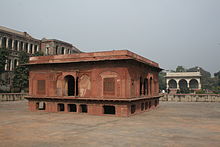 The Hayat Bakhsh Bagh (Persian: حیات بخش باغ, lit. 'Life-Bestowing Garden') is located in the northeast part of the complex. At each end of the canal within the Red Fort is a white marble pavilion, named the Sawan and Bhadon Pavilions, after the Hindu months of Sawan and Bhadon. At the center of the reservoir stands the Zafar Mahal, an eponymous red sandstone structure added around 1842 by Bahadur Shah Zafar.[83] Smaller gardens, such as the Mehtab Bagh (Moonlight Garden), once existed to the west of the main garden but were demolished during the construction of British barracks.[11] There are plans to restore the gardens.[84] Beyond these structures, a road to the north leads to an arched bridge connecting to the Salimgarh Fort. Princes' quarterTo the north of the Hayat Bakhsh Bagh and the Shahi Burj lies the quarter of the imperial princes, which was used by members of the Mughal royal family. Much of this area was demolished by British forces after the 1857 rebellion, with one of the palaces being repurposed into a tea house for soldiers. See also
References
External links
|
||||||||||||||||||||||||||||||||||||||

